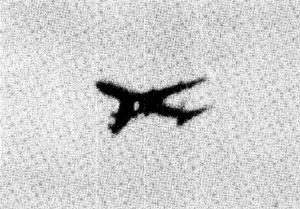Difference between revisions of "Japan Air Lines Flight 123"
(air crash stub) |
m (add image) |
||
| Line 2: | Line 2: | ||
|wikipedia=https://en.wikipedia.org/wiki/Japan_Air_Lines_Flight_123 | |wikipedia=https://en.wikipedia.org/wiki/Japan_Air_Lines_Flight_123 | ||
|constitutes=aircraft crash | |constitutes=aircraft crash | ||
| − | |image= | + | |image=Japan Airlines 123 124 The accident aircraft flying over Okutama.png |
| + | |image_caption=The stricken jet photographed approximately 6 minutes before the crash. The vertical stabilizer is largely missing. | ||
|description=The deadliest single-aircraft accident in aviation history. | |description=The deadliest single-aircraft accident in aviation history. | ||
|occurred= August 12, 1985 | |occurred= August 12, 1985 | ||
Latest revision as of 00:36, 18 May 2024
 The stricken jet photographed approximately 6 minutes before the crash. The vertical stabilizer is largely missing. | |
| Date | August 12, 1985 |
|---|---|
| Location | Japan |
| Description | The deadliest single-aircraft accident in aviation history. |
Japan Air Lines Flight 123 was a scheduled domestic passenger flight from Tokyo to Osaka, Japan. On August 12, 1985, the Boeing 747 flying the route suffered a severe structural failure and decompression 12 minutes into the flight. After flying under minimal control for a further 32 minutes, the 747 crashed in the area of Mount Takamagahara, 100 kilometres (62 mi; 54 nmi) from Tokyo.
Official narrative
The aircraft, featuring a high-density seating configuration, was carrying 524 people. The crash killed all 15 crew members and 505 of the 509 passengers on board, leaving only four survivors. An estimated 20 to 50 passengers also survived the initial crash, but died a few hours later while awaiting rescue due to their serious injuries. The crash of Flight 123 is the deadliest single-aircraft accident in aviation history.[1]
Japan's Aircraft Accident Investigation Commission (AAIC),[2] assisted by the U.S. National Transportation Safety Board,[3] concluded that the structural failure was caused by a faulty repair by Boeing technicians following a tailstrike incident seven years earlier. When the faulty repair eventually failed, it resulted in a rapid decompression that ripped off a large portion of the tail and caused the loss of all on-board hydraulic systems, disabling the aircraft's flight controls.
Problems with the official narrative
Some relatives of the victims have not been satisfied with the official narrative.[4]
The critical parts of the plane, most of the vertical fin and tails constructions that came off, are still in the sea. Despite being the official narrative direct cause, it is still sunk on the seabed at 160m in Sagami Bay, below the flight route. These parts are the origin of the accident, nevertheless the Japan Transport Safety Commission refused the wishes of the bereaved and rejected to pull them up from the seabed for a reinvestigation.[4]
The accident investigation report disregarded the testimonies of many witnesses. According to them, 2 Self-Defense Force Phantom 2 fighters were witnessed following the aircraft before the crash.[5]
Of possible relevance[6] is that the incident happened a month before the Plaza Accord, an joint agreement signed on September 22, 1985, at the Plaza Hotel in New York City, between France, West Germany, Japan, the United Kingdom, and the United States, to depreciate the U.S. dollar by intervening in currency markets. The Plaza Accord was the main cause of the Japanese asset price bubble of the late 1980s an the Japanese "lost decade".[7]
References
- ↑ https://web.archive.org/web/20220510004708/https://aviation-safety.net/database/record.php?id=19850812-1
- ↑ https://web.archive.org/web/20160204052600/http://www.mlit.go.jp/jtsb/eng-air_report/JA8119.pdf
- ↑ https://web.archive.org/web/20210226052256/https://www.japantimes.co.jp/news/2015/08/11/national/history/u-s-leaked-crucial-boeing-repair-flaw-led-1985-jal-jet-crash-ex-officials/
- ↑ a b https://www.japansubculture.com/british-widow-fights-to-know-the-truth-on-34th-anniversary-of-the-japan-airlines-flight-123-crash/
- ↑ https://tenku123.hateblo.jp/entry/2016/08/12/014933
- ↑ https://tenku123.hateblo.jp/entry/2020/09/22/153245
- ↑ https://www.investopedia.com/terms/p/plaza-accord.asp